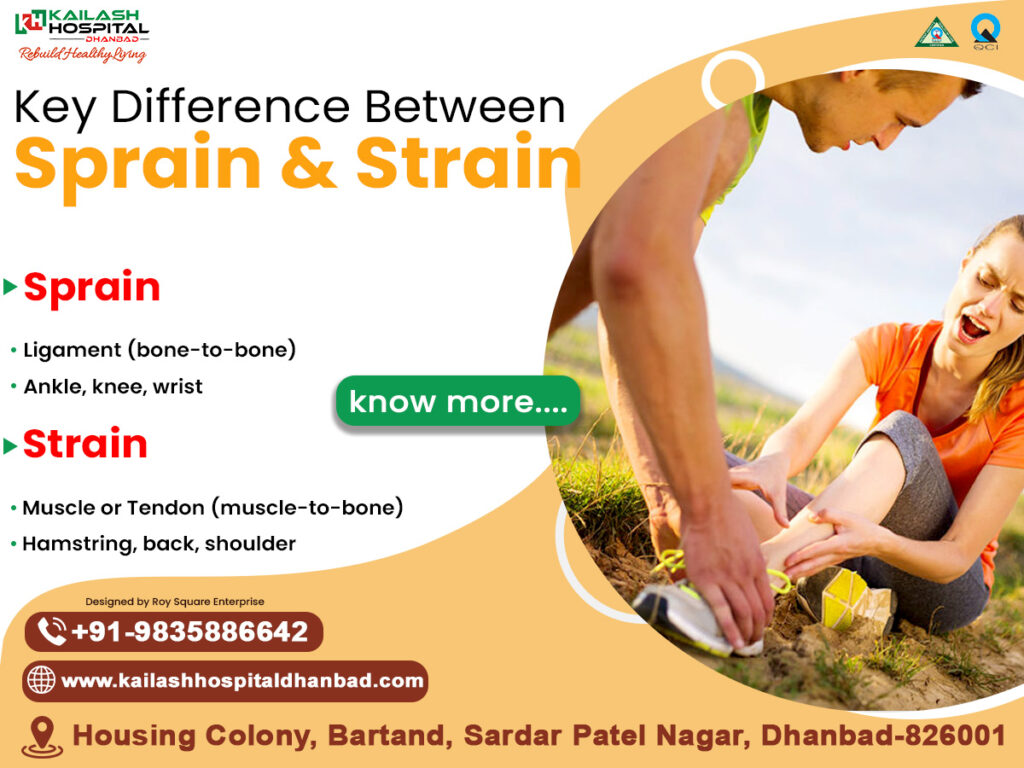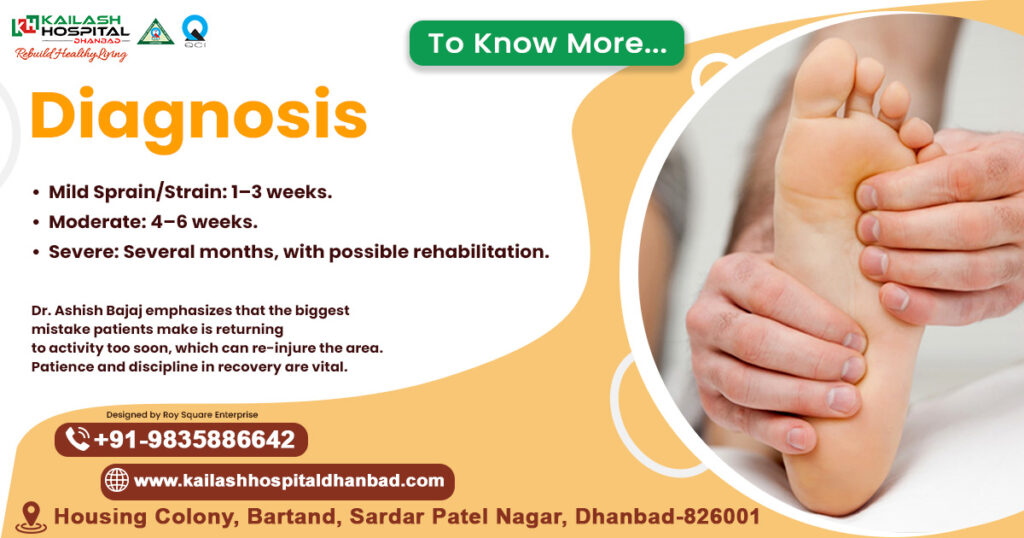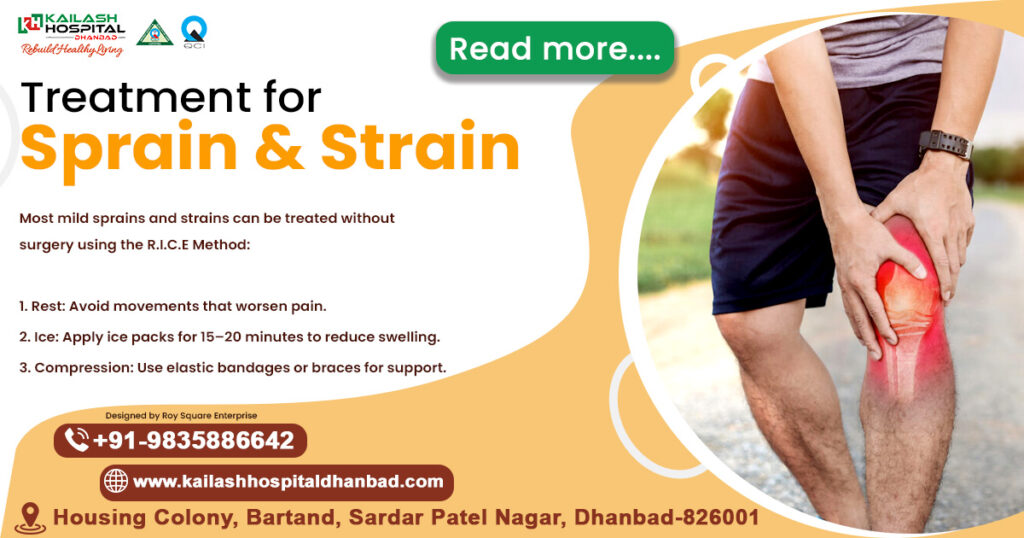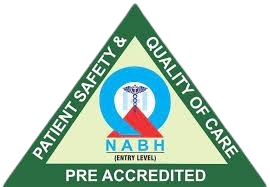Injuries are a common part of life, whether you are an athlete, a working professional, or even someone doing daily household chores. Among the most frequent injuries are sprains and strains. Although these two terms are often used interchangeably, they are not the same.
According to Dr. Ashish Bajaj, Consultant Orthopedics at Kailash Hospital, Best orthopaedic in Dhanbad, understanding the difference between a sprain and a strain is crucial for proper diagnosis, timely treatment, and effective recovery. Misinterpreting the two can delay healing and worsen the injury.
This blog will take you through the key differences between sprain and strain, their symptoms, causes, treatment, prevention tips, FAQs, and myths vs facts — all explained in a simple yet professional manner.
What is a Sprain?
A sprain occurs when the ligaments (the tough bands of tissue connecting bones to each other in a joint) are stretched or torn.
- Commonly Affected Areas: Ankles, knees, and wrists.
- Cause: Usually happens due to sudden twists, falls, or awkward landings.
Dr. Ashish Bajaj explains that ankle sprains are among the most common injuries he sees at Kailash Hospital, Dhanbad, especially in athletes and people who walk on uneven surfaces.
What is a Strain?
A strain happens when the muscles or tendons (the tissues that connect muscles to bones) are overstretched or torn.
- Commonly Affected Areas: Back, hamstrings, shoulders.
- Cause: Usually results from heavy lifting, sudden pulling movements, or overuse of muscles.
Dr. Ashish Bajaj points out that strains are very common in people with sedentary desk jobs who suddenly start exercising without proper warm-up.

Key Difference Between Sprains and Strains
| Aspect | Sprain | Strain |
| Tissue Affected | Ligament (bone-to-bone) | Muscle or Tendon (muscle-to-bone) |
| Common Sites | Ankle, knee, wrist | Hamstring, back, shoulder |
| Cause | Sudden twist, fall, sports injury | Overstretching, heavy lifting, overuse |
| Symptoms | Swelling, bruising, pain around joint, limited mobility | Muscle spasm, weakness, pain during movement, cramping |
| Healing Time | Weeks to months (depends on severity) | Days to weeks (mild) or longer if severe |
| Treatment | RICE, physiotherapy, sometimes surgery | Rest, ice, stretching, physiotherapy |
Symptoms of Sprain (Ligament Injury)
A sprain occurs when the ligaments around a joint are stretched or torn. Common symptoms include sudden pain, swelling, bruising, and stiffness, making it difficult to move the joint normally. Some people may also hear or feel a “pop” at the moment of injury, especially in the ankle or wrist. The affected area is often tender to touch, and weight-bearing can become very painful.
- Swelling around the affected joint
- Bruising or discoloration
- Pain when moving or touching the joint
- Limited range of motion
- “Popping” sound at the time of injury
Symptoms of Strain (Muscle or Tendon Injury)
A strain happens when a muscle or tendon is overstretched or torn. Typical symptoms include sharp pain in the muscle, weakness, tenderness, and swelling. Many patients also experience muscle spasms or cramps, and the pain usually increases when the muscle is stretched or used. Strains are common in the back, hamstrings, and shoulders, often due to overuse, sudden pulling movements, or heavy lifting.
- Sudden sharp pain in the muscle
- Muscle weakness
- Spasms or cramps
- Difficulty in moving the affected area
- Swelling or tenderness
Causes & Risk Factors
Sprain Causes
- Falling or landing awkwardly
- Walking on uneven ground
- Sports injuries (football, basketball, running)
- Sudden twists or turns
Strain Causes
- Lifting heavy objects without support
- Poor posture over long hours
- Lack of warm-up before exercise
- Repetitive motion or overuse

Diagnosis
Dr. Ashish Bajaj notes that diagnosis is usually based on clinical examination and, if necessary, imaging tests.
- Sprains: X-rays to rule out fractures, MRI to check ligament damage.
- Strains: Physical exam, MRI or ultrasound to assess muscle/tendon tears.

Treatment for Sprain & Strain
Most mild sprains and strains can be treated without surgery using the R.I.C.E Method:
- Rest: Avoid movements that worsen pain.
- Ice: Apply ice packs for 15–20 minutes to reduce swelling.
- Compression: Use elastic bandages or braces for support.
- Elevation: Keep the injured area elevated above heart level.
Additional Treatments
- Medication: Anti-inflammatory painkillers.
- Physiotherapy: Essential for regaining mobility and strength.
- Steroid injections: In severe inflammation cases.
- Surgery: Rarely required for severe ligament or tendon tears.
At Kailash Hospital, Dhanbad, Dr. Ashish Bajaj and his team provide comprehensive orthopedic care, including advanced physiotherapy and minimally invasive surgical options when needed.
Prevention Tips
- Always warm up before workouts.
- Wear supportive shoes on uneven surfaces.
- Maintain good posture while sitting or lifting.
- Avoid sudden heavy lifting without preparation.
- Strengthen muscles with regular exercise.
Recovery Time
- Mild Sprain/Strain: 1–3 weeks.
- Moderate: 4–6 weeks.
- Severe: Several months, with possible rehabilitation.
Dr. Ashish Bajaj emphasizes that the biggest mistake patients make is returning to activity too soon, which can re-injure the area. Patience and discipline in recovery are vital.
Top 10 FAQs about Sprain & Strain
- What is the main difference between a sprain and a strain?
A sprain affects ligaments, while a strain affects muscles or tendons. - Which is more painful: a sprain or a strain?
Both can be painful, but severe sprains often cause more swelling and bruising. - How can I tell if I have a sprain or strain?
Sprains usually involve joint pain with swelling, while strains cause muscle weakness and spasms. - Can I walk on a sprained ankle?
Mild sprains may allow walking, but rest is recommended to avoid worsening the injury. - Do sprains and strains heal on their own?
Mild cases may heal naturally with rest, but proper care speeds up recovery. - When should I see a doctor?
If pain, swelling, or immobility persists for more than a few days. - Do I need surgery for a sprain or strain?
Most cases don’t require surgery, but severe ligament or tendon tears might. - Can physiotherapy help in sprains and strains?
Yes, it restores mobility, strength, and prevents long-term stiffness. - Are sprains and strains preventable?
Yes, with warm-ups, posture correction, and muscle strengthening. - Who should I consult for sprains and strains?
An orthopedic specialist Dr. Ashish Bajaj at Kailash Hospital, Dhanbad.
Top 10 Myths vs Facts about Sprains and Strains
Myth 1: Sprain and strain mean the same thing.
Fact: Sprain = ligament injury; Strain = muscle/tendon injury.
Myth 2: You should always keep moving after such injuries.
Fact: Rest is essential initially; forced movement worsens injury.
Myth 3: Only athletes get sprains and strains.
Fact: Anyone can suffer, even during daily activities.
Myth 4: Ice and rest are enough for healing.
Fact: Physiotherapy is equally important for complete recovery.
Myth 5: A sprain is less serious than a fracture.
Fact: Severe sprains can be just as limiting and require medical care.
Myth 6: Once healed, the injured area won’t get hurt again.
Fact: Previous injury sites are more vulnerable without proper rehab.
Myth 7: Surgery is always required for severe cases.
Fact: Only a small percentage need surgery; most heal with non-surgical care.
Myth 8: Painkillers are enough for treatment.
Fact: They help symptoms but don’t fix the root issue.
Myth 9: Sprains/strains heal within a few days.
Fact: Healing can take weeks or months, depending on severity.
Myth 10: Consulting a doctor is unnecessary for minor injuries.
Fact: Early consultation prevents long-term complications.



